Trump’s Foreign Policy: Year One
2017
President Trump’s first year signaled a profound departure of U.S. leadership in areas like trade and climate policy, and an across-the-board toughening of immigration practices. The moves reflected the administration’s push for an America First agenda.
Start 2017

Former President Barack Obama and Michelle Obama stand with President Donald J. Trump and Melania Trump at the 2017 inauguration. Reuters
Jan 20, 2017
Inauguration
In his inaugural address, President Donald J. Trump announces an America First approach to foreign policy and trade, which centers on reducing U.S. trade deficits and rebalancing burden sharing within alliances. Trump promises to “unite the civilized world against radical Islamic terrorism” and emphasizes that “it is the right of all nations to put their own interests first.”

Trump signs an executive order withdrawing the United States from the Trans-Pacific Partnership. Getty Images
Jan 23, 2017
TPP Withdrawal
Trump directs the Office of the U.S. Trade Representative to withdraw the United States from the Trans-Pacific Partnership, a twelve-country, Asia-focused trade agreement the United States had championed under the Obama administration.

Demonstrators protest outside San Francisco International Airport. Kate Munsch/Reuters
Jan 27, 2017
Travel Ban
The president signs an executive order banning nationals of six Muslim-majority countries from traveling to the United States for ninety days. The order, later amended to include an additional two countries, also indefinitely freezes refugee intake from Syria. Days later, a federal judge in Washington State blocks part of the order, beginning a series of judicial challenges. That same week, President Trump signs two other executive orders concerning immigration. One directs federal funds to the construction of a wall along the U.S.-Mexico border, and the other bars so-called sanctuary cities from receiving federal grants.

Satellite imagery shows the Shayrat Air Base, outside of Homs, following a U.S. missile strike. Digital Globe/Getty
Apr 7, 2017
Striking Syria
In retaliation for Syrian President Bashar al-Assad’s use of the chemical weapon sarin in an attack against civilians, Trump authorizes a limited cruise missile strike on the regime-controlled Shayrat Air Base. U.S.-sponsored measures against the regime at the UN Security Council are blocked by Russia, part of a long-running trend.

Mexican Economy Minister Ildefonso Guajardo, Canadian Foreign Minister Chrystia Freeland, and U.S. Trade Representative Robert Lighthizer meet on NAFTA in Ottawa. Chris Wattie/Reuters
May 18, 2017
Revisiting NAFTA
U.S. Trade Representative Robert Lighthizer notifies Congress [PDF] of the White House’s intent to “modernize” the North American Free Trade Agreement (NAFTA). The administration seeks to renegotiate the agreement, whose other parties are Canada and Mexico, to address the U.S. trade deficit in goods, eliminate subsidies it sees as unfair, restore manufacturing jobs, and ease intellectual property restrictions.
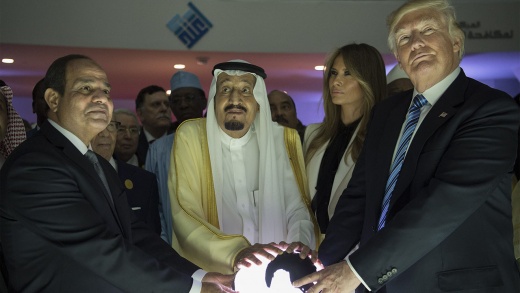
Trump and Arab leaders inaugurate a counterterrorism center in Riyadh.Anadolu Agency/Getty
May 20, 2017 – May 27, 2017
Trump Goes Abroad
Trump makes his first trip abroad as president, traveling to Saudi Arabia, Israel, the West Bank, Italy, Vatican City, Belgium, and Italy. He attends a summit in Riyadh with leaders from more than fifty Arab- and Muslim-majority nations, where he delivers a speech calling on the Muslim world to unite against terrorism. In Brussels, Trump addresses North Atlantic Treaty Organization (NATO) heads of state and government, calling on each of them to “finally contribute their fair share” to the alliance. He does not, however, explicitly state his support for NATO’s Article 5 mutual defense clause. In Italy, Trump participates in the Group of Seven meeting, where the United States joins a joint declaration on fighting protectionism but withholds its support from one reaffirming the Paris climate accord.
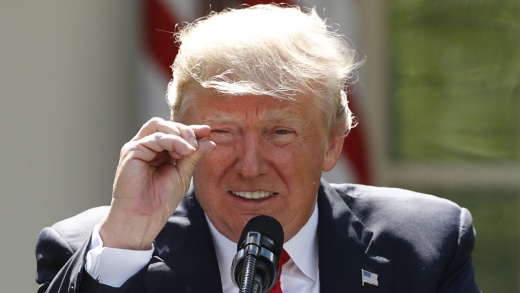
Trump refers to the magnitude of global climate change as he announces his decision to withdraw the United States from the landmark Paris climate agreement. Kevin Lamarque/Reuters
Jun 1, 2017
Leaving the Paris Agreement
In a speech, President Trump announces that the United States will withdraw from the 2015 Paris climate accord, another agreement negotiated by Obama. Trump criticizes the 195-country agreement, under which the United States would have voluntarily limited its carbon emissions, for constricting U.S. sovereignty, harming American workers, and disadvantaging the United States economically.

A girl holds a picture depicting Qatari Emir Sheikh Tamim bin Hamad al-Thani.Naseem Zeitoun/Reuters
Jun 5, 2017
Navigating Qatar's Crisis
Saudi Arabia, the United Arab Emirates, Bahrain, and Egypt sever diplomatic relations with Qatar, alleging it supports terrorism and Iranian adventurism. Trump initially welcomes the move even as Secretary of State Rex Tillerson and Secretary of Defense Jim Mattis work to reinforce the U.S. relationship with Qatar, which hosts the al-Udeid Air Base, the regional headquarters of U.S. Central Command.
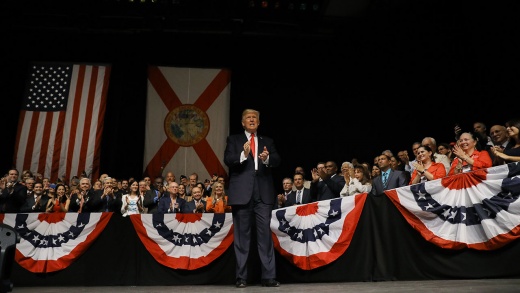
Trump prepares to deliver a speech on U.S.-Cuba relations. Carlos Barria/Reuters
Jun 16, 2017
Rolling Back Ties With Cuba
Trump announces a partial rollback of the Obama administration’s rapprochement with Cuba. Under the newly announced guidelines, the United States will reinstate restrictions on travel and trade with Cuba without severing diplomatic ties. In September 2017, the Trump administration reduces the U.S. embassy staff in Havana by half.
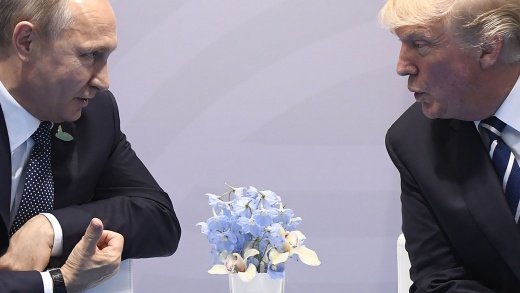
Trump and Russian President Vladimir Putin meet on the sidelines of the G20 summit in Hamburg, Germany. Saul Loeb/Getty
Jul 5, 2017 – Jul 8, 2017
Trump Meets Putin
In a visit to Warsaw, Trump delivers an address in which he emphasizes a civilizational struggle for the West and, for the first time, explicitly references NATO’s mutual defense clause. In Germany, Trump attends the Group of Twenty leaders’ meeting, where he meets for the first time as president with Russian President Vladimir Putin. The meeting is highly anticipated amid ongoing investigations into Russian interference in the 2016 U.S. elections.
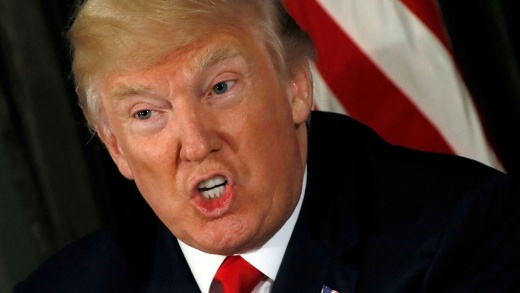
Trump speaks about North Korea during a briefing. Jonathan Ernst/Reuters
Aug 8, 2017
A War of Words With North Korea
After Pyongyang threatens to launch ballistic missiles into the waters around Guam, Trump warns that North Korea will be met with “fire and fury” if it continues to threaten launches. The remark initiates hostile rhetorical exchanges that culminate with Kim Jong-un insulting Trump.
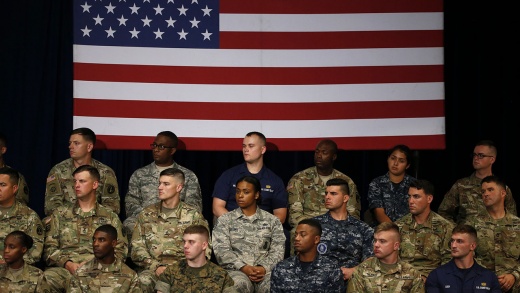
Military personnel watch as Trump announces his strategy for the war in Afghanistan. Joshua Roberts/Reuters
Aug 21, 2017
A New Afghan Strategy
Trump, in a speech, announces a counterterrorism-focused approach to the U.S. mission in Afghanistan. He announces that he will deploy more U.S. troops there and loosen their rules of engagement. He avoids mentioning deployment timetables.
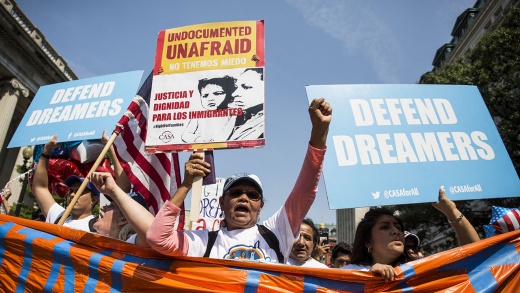
Protesters demonstrate against the Trump administration’s announcement that it will end the Deferred Action for Childhood Arrivals program. Zach Gibson/Getty
Sep 5, 2017
Winding Down DACA
Trump and Attorney General Jeff Sessions announce that the Obama-era Deferred Action for Childhood Arrivals (DACA) program will begin winding down in six months, leaving approximately eight hundred thousand beneficiaries vulnerable to deportation. Trump encourages Congress to legislate a successor to DACA.

Trump waits to address the UN General Assembly in New York. Drew Angerer/Getty
Sep 19, 2017
A UN Debut
Trump, addressing the UN General Assembly for the first time, threatens to “totally destroy” North Korea if the United States is “forced to defend itself or its allies.” Echoing his inaugural address, Trump emphasizes sovereignty and tells the gathered world leaders that the United States does “not seek to impose our way of life on anyone, but rather to let it shine as an example for everyone to watch.”

Trump speaks about the Iran nuclear deal. Reuters
Oct 13, 2017
Revisiting the Iran Deal
After months of deliberation, Trump announces that he will not recertify Iran’s compliance with the 2015 Joint Comprehensive Plan of Action to Congress (JCPOA), saying that Iran’s behavior violates the spirit of the agreement. Trump does not take steps to abrogate the JCPOA; instead, he asks Congress to deliberate on reimposing sanctions.

Trump is welcomed to Tokyo by Japanese Prime Minister Shinzo Abe. Reuters
Nov 3, 2017 – Nov 14, 2017
Trump Goes to Asia
Trump travels to Japan, South Korea, China, Vietnam, and the Philippines on his longest trip yet. In addition to introducing a new vision for U.S. involvement in the “Indo-Pacific,” North Korea and trade dominate the agenda. In Vietnam, Trump attends the Asia-Pacific Economic Cooperation summit and delivers an address reinforcing his America First vision on trade. In Manila, on the sidelines of the Association of Southeast Asian Nations summits, officials from the United States, Japan, Australia, and India convene a quadrilateral meeting of like-minded democracies with concerns about China’s rise.

Palestinians protest following the first Friday prayer after Trump's recognition of Jerusalem at the al-Aqsa Mosque compound in Jerusalem’s Old City. Ahmad Gharabli/Getty
Dec 6, 2017
Recognizing Jerusalem
Trump breaks with decades of U.S. policy on the Israeli-Palestinian conflict by recognizing Jerusalem as Israel’s capital. He justifies the move as a recognition of the reality that Jerusalem is the seat of Israel’s government.
Trump’s Foreign Policy: Year One
2017
President Trump’s first year signaled a profound departure of U.S. leadership in areas like trade and climate policy, and an across-the-board toughening of immigration practices. The moves reflected the administration’s push for an America First agenda.
Start 2017

Former President Barack Obama and Michelle Obama stand with President Donald J. Trump and Melania Trump at the 2017 inauguration. Reuters
Jan 20, 2017
Inauguration
In his inaugural address, President Donald J. Trump announces an America First approach to foreign policy and trade, which centers on reducing U.S. trade deficits and rebalancing burden sharing within alliances. Trump promises to “unite the civilized world against radical Islamic terrorism” and emphasizes that “it is the right of all nations to put their own interests first.”

Trump signs an executive order withdrawing the United States from the Trans-Pacific Partnership. Getty Images
Jan 23, 2017
TPP Withdrawal
Trump directs the Office of the U.S. Trade Representative to withdraw the United States from the Trans-Pacific Partnership, a twelve-country, Asia-focused trade agreement the United States had championed under the Obama administration.

Demonstrators protest outside San Francisco International Airport. Kate Munsch/Reuters
Jan 27, 2017
Travel Ban
The president signs an executive order banning nationals of six Muslim-majority countries from traveling to the United States for ninety days. The order, later amended to include an additional two countries, also indefinitely freezes refugee intake from Syria. Days later, a federal judge in Washington State blocks part of the order, beginning a series of judicial challenges. That same week, President Trump signs two other executive orders concerning immigration. One directs federal funds to the construction of a wall along the U.S.-Mexico border, and the other bars so-called sanctuary cities from receiving federal grants.

Satellite imagery shows the Shayrat Air Base, outside of Homs, following a U.S. missile strike. Digital Globe/Getty
Apr 7, 2017
Striking Syria
In retaliation for Syrian President Bashar al-Assad’s use of the chemical weapon sarin in an attack against civilians, Trump authorizes a limited cruise missile strike on the regime-controlled Shayrat Air Base. U.S.-sponsored measures against the regime at the UN Security Council are blocked by Russia, part of a long-running trend.

Mexican Economy Minister Ildefonso Guajardo, Canadian Foreign Minister Chrystia Freeland, and U.S. Trade Representative Robert Lighthizer meet on NAFTA in Ottawa. Chris Wattie/Reuters
May 18, 2017
Revisiting NAFTA
U.S. Trade Representative Robert Lighthizer notifies Congress [PDF] of the White House’s intent to “modernize” the North American Free Trade Agreement (NAFTA). The administration seeks to renegotiate the agreement, whose other parties are Canada and Mexico, to address the U.S. trade deficit in goods, eliminate subsidies it sees as unfair, restore manufacturing jobs, and ease intellectual property restrictions.

Trump and Arab leaders inaugurate a counterterrorism center in Riyadh.Anadolu Agency/Getty
May 20, 2017 – May 27, 2017
Trump Goes Abroad
Trump makes his first trip abroad as president, traveling to Saudi Arabia, Israel, the West Bank, Italy, Vatican City, Belgium, and Italy. He attends a summit in Riyadh with leaders from more than fifty Arab- and Muslim-majority nations, where he delivers a speech calling on the Muslim world to unite against terrorism. In Brussels, Trump addresses North Atlantic Treaty Organization (NATO) heads of state and government, calling on each of them to “finally contribute their fair share” to the alliance. He does not, however, explicitly state his support for NATO’s Article 5 mutual defense clause. In Italy, Trump participates in the Group of Seven meeting, where the United States joins a joint declaration on fighting protectionism but withholds its support from one reaffirming the Paris climate accord.

Trump refers to the magnitude of global climate change as he announces his decision to withdraw the United States from the landmark Paris climate agreement. Kevin Lamarque/Reuters
Jun 1, 2017
Leaving the Paris Agreement
In a speech, President Trump announces that the United States will withdraw from the 2015 Paris climate accord, another agreement negotiated by Obama. Trump criticizes the 195-country agreement, under which the United States would have voluntarily limited its carbon emissions, for constricting U.S. sovereignty, harming American workers, and disadvantaging the United States economically.

A girl holds a picture depicting Qatari Emir Sheikh Tamim bin Hamad al-Thani.Naseem Zeitoun/Reuters
Jun 5, 2017
Navigating Qatar's Crisis
Saudi Arabia, the United Arab Emirates, Bahrain, and Egypt sever diplomatic relations with Qatar, alleging it supports terrorism and Iranian adventurism. Trump initially welcomes the move even as Secretary of State Rex Tillerson and Secretary of Defense Jim Mattis work to reinforce the U.S. relationship with Qatar, which hosts the al-Udeid Air Base, the regional headquarters of U.S. Central Command.

Trump prepares to deliver a speech on U.S.-Cuba relations. Carlos Barria/Reuters
Jun 16, 2017
Rolling Back Ties With Cuba
Trump announces a partial rollback of the Obama administration’s rapprochement with Cuba. Under the newly announced guidelines, the United States will reinstate restrictions on travel and trade with Cuba without severing diplomatic ties. In September 2017, the Trump administration reduces the U.S. embassy staff in Havana by half.

Trump and Russian President Vladimir Putin meet on the sidelines of the G20 summit in Hamburg, Germany. Saul Loeb/Getty
Jul 5, 2017 – Jul 8, 2017
Trump Meets Putin
In a visit to Warsaw, Trump delivers an address in which he emphasizes a civilizational struggle for the West and, for the first time, explicitly references NATO’s mutual defense clause. In Germany, Trump attends the Group of Twenty leaders’ meeting, where he meets for the first time as president with Russian President Vladimir Putin. The meeting is highly anticipated amid ongoing investigations into Russian interference in the 2016 U.S. elections.

Trump speaks about North Korea during a briefing. Jonathan Ernst/Reuters
Aug 8, 2017
A War of Words With North Korea
After Pyongyang threatens to launch ballistic missiles into the waters around Guam, Trump warns that North Korea will be met with “fire and fury” if it continues to threaten launches. The remark initiates hostile rhetorical exchanges that culminate with Kim Jong-un insulting Trump.

Military personnel watch as Trump announces his strategy for the war in Afghanistan. Joshua Roberts/Reuters
Aug 21, 2017
A New Afghan Strategy
Trump, in a speech, announces a counterterrorism-focused approach to the U.S. mission in Afghanistan. He announces that he will deploy more U.S. troops there and loosen their rules of engagement. He avoids mentioning deployment timetables.

Protesters demonstrate against the Trump administration’s announcement that it will end the Deferred Action for Childhood Arrivals program. Zach Gibson/Getty
Sep 5, 2017
Winding Down DACA
Trump and Attorney General Jeff Sessions announce that the Obama-era Deferred Action for Childhood Arrivals (DACA) program will begin winding down in six months, leaving approximately eight hundred thousand beneficiaries vulnerable to deportation. Trump encourages Congress to legislate a successor to DACA.

Trump waits to address the UN General Assembly in New York. Drew Angerer/Getty
Sep 19, 2017
A UN Debut
Trump, addressing the UN General Assembly for the first time, threatens to “totally destroy” North Korea if the United States is “forced to defend itself or its allies.” Echoing his inaugural address, Trump emphasizes sovereignty and tells the gathered world leaders that the United States does “not seek to impose our way of life on anyone, but rather to let it shine as an example for everyone to watch.”

Trump speaks about the Iran nuclear deal. Reuters
Oct 13, 2017
Revisiting the Iran Deal
After months of deliberation, Trump announces that he will not recertify Iran’s compliance with the 2015 Joint Comprehensive Plan of Action to Congress (JCPOA), saying that Iran’s behavior violates the spirit of the agreement. Trump does not take steps to abrogate the JCPOA; instead, he asks Congress to deliberate on reimposing sanctions.

Trump is welcomed to Tokyo by Japanese Prime Minister Shinzo Abe. Reuters
Nov 3, 2017 – Nov 14, 2017
Trump Goes to Asia
Trump travels to Japan, South Korea, China, Vietnam, and the Philippines on his longest trip yet. In addition to introducing a new vision for U.S. involvement in the “Indo-Pacific,” North Korea and trade dominate the agenda. In Vietnam, Trump attends the Asia-Pacific Economic Cooperation summit and delivers an address reinforcing his America First vision on trade. In Manila, on the sidelines of the Association of Southeast Asian Nations summits, officials from the United States, Japan, Australia, and India convene a quadrilateral meeting of like-minded democracies with concerns about China’s rise.

Palestinians protest following the first Friday prayer after Trump's recognition of Jerusalem at the al-Aqsa Mosque compound in Jerusalem’s Old City. Ahmad Gharabli/Getty
Dec 6, 2017
Recognizing Jerusalem
Trump breaks with decades of U.S. policy on the Israeli-Palestinian conflict by recognizing Jerusalem as Israel’s capital. He justifies the move as a recognition of the reality that Jerusalem is the seat of Israel’s government.
Trump’s Foreign Policy: Year One
Last edited:
